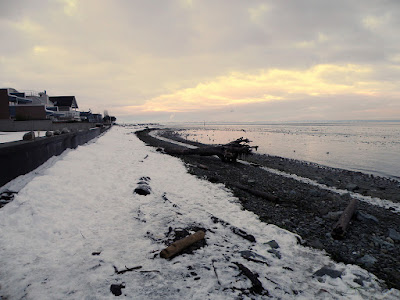So we were late coming down to the beach. The sun was setting already.

We came to the end of the road to the beach, and gasped; the shore was swarming with birds.

At first, we saw only the seagulls and ducks. The ducks were resting quietly, in rafts and lines here and there all over the bay, or taking an leisurly evening constitutional; the occasional one up-ended to pick up a last bite of supper. The seagulls were mostly by the shore, squabbling and shrieking as they do when there is anything to grab.

Second raft of ducks and gulls, just beyond the post. Another behind that, barely visible.

Assorted ducks.
The ducks were mostly mallards, but there were a few smaller ones. The colours were indistinguishable in the fading light. I think I saw a few shovellers, too, but I can't be sure.

Mini-bergs
The snow on the shore ended at the high-tide line, as expected. But there was another line of snow further down. And in the water, what I took at first to be seaweed turned out to be floating chunks of ice. I've never seen that in these waters before.
It was getting hard to distinguish the birds; the light was failing. We walked closer to the waterline to get a better angle on them, and after a bit, I noticed movement in the shadows almost at my feet.

Sandpipers! A constantly-moving, peeping, dancing flock of sandpipers. Or dunlins, or ... It was hard to know; they blended in with the rocks and sand so well. Now, looking back at the seagulls, we could see that in places the stones seemed to be moving around their feet; more sandpipers.

There seemed to be two kinds; an occasional larger sandpiper, and larger groupings of little starling-sized waders. Dunlins?
But what was attracting them? Along the sand, I could see daubs of orangey colour; I turned on the flash.

Crab on ice.
The orange bits were pieces of crab. Shells and broken claws, pieces of leg. They were all over the sand, tangled in the eelgrass, floating in the wavelets. Clumps of sandpipers gathered around the bigger pieces; seagulls few past with their bills full of dangling crab entrails.

A blurry shot, panning with the movement, but not fast enough.
Among the crab parts, we found several dead starfish.

Most of them were of the purple variety, like this one, but very faded, so that even with flash, they blended into the grey of the stones. All were obviously dead. I didn't see any of the sandpipers working on them; I'm sure the seagulls would be.
I've been wondering since; what caused the sudden influx of dead crabs and starfish? Is this normal? Were they killed by the sudden cold snap? Or is it just the time of the year for a die-off?

One last shot, before we left; these were visible in the dark only as blurry whitish blobs. (All of these photos have been lightened considerably; they showed up at first as grey on black. Most were unusable; the cameras couldn't manage to freeze the action with that little light.)

One last shot, before we left; these were visible in the dark only as blurry whitish blobs. (All of these photos have been lightened considerably; they showed up at first as grey on black. Most were unusable; the cameras couldn't manage to freeze the action with that little light.)
Talking of freezing; we were on the edge. We drove home with the heater on full-blast.
.
.

Fascinating! Shows what happens when you go somewhere usual at an unusual time! The shorebirds are Dunlin (the darker ones) and (I think) Sanderling (the pale ones).
ReplyDeleteThe Boundary Bay Checklist lists them as winter-abundant and -common respectively.
http://www3.telus.net/driftwood/boundbl.htm
Interesting about the crab/seastar mortality. Echinoderms are killed by freshwater, so maybe all this precip has done them in.